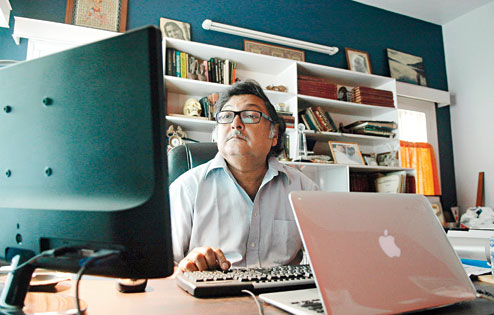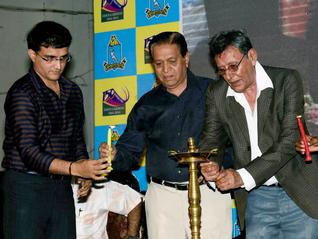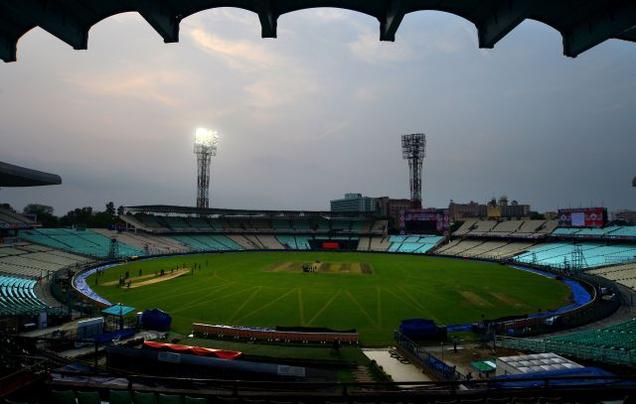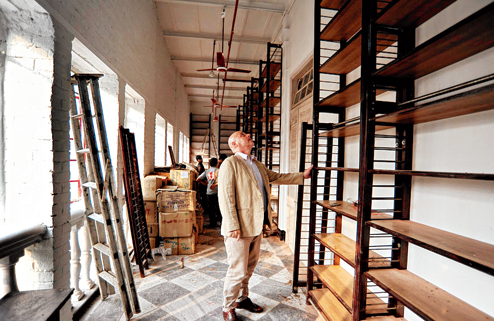
Calcutta-born education scientist Sugata Mitra grew up in a strict Jesuit-school environment in Delhi where life was all about discipline and order.
Little did he know that one day his life would be all about “theories of chaos”, the key to a series of self-organised learning environments that are transforming the way education is imparted.
Mitra, a physicist by training and a polymath by choice, is the winner of the 2013 TED prize that fetched one million dollars for his radical educational project School in the Cloud. Seven such experimental facilities have since been launched in the UK and India, three of them in Bengal.
Apart from giving shape to his vision, the 62-year-old scientist is making the most of his stay in Calcutta with “a daily visit to the bazaar to shop for fish and duck eggs”.
For Mitra, professor of educational technology at Newcastle University in the UK since 2006, each day is about implementing what he calls SOLE, or unsupervised self-organised learning environment. This theory forms the basis of his School in the Cloud concept, a term that he first used in a riveting speech after winning the TED award last year.
Mitra was the first recipient of the one-million-dollar purse since it was raised from $100,000. Past winners of the prize, awarded by the non-profit Sapling Foundation to foster the spread of “great ideas”, include Bill Clinton and Bono.
The journey to worldwide recognition of Mitra’s great ideas started with a winning experiment in 1999 called Hole in the Wall. The then Delhi-based scientist and educator embedded a computer within a wall in a Kalkaji slum and children were allowed to use it freely. The experiment proved that kids could quickly learn computers on their own without any formal training.
Mitra called it Minimally Invasive Education and the experiment caught on, even inspiring the novel Q&A by Vikas Swarup that Danny Boyle adapted into the Oscar-winning Slumdog Millionaire.
The unintended connection with Slumdog Millionaire is not something he is excited about. “I was quite startled at first because I couldn’t see the connection,” Mitra said of the film. “The fact that you can learn by yourself was put into a very different, rather sad context. I wish that one wouldn’t have to learn under the circumstances as we see in the movie.”
So would he have approved if the story didn’t feed on the rags-to-riches formula?
“I found Vikas Swarup on the Web after the film released in England and wrote to him. We were in correspondence and I still feel it would have been better if it were about a slumdog professor who did not win a million-dollar game show but went on to become a professor!” Mitra said.
School in the Cloud, which has brought Mitra back to Calcutta, started in the UK three months ago. “It’s a three-year research project and according to the budget, a maximum of seven locations is what I could afford (with the prize money). The challenge was to find those seven places,” Mitra said.
In England, he picked George Stephenson High School, “where the steam engine man George Stephenson lived”, and another in the rural hamlet of Durham. In India, he found a school each in Delhi and a town called Phaltan, near Pune, besides the three in Bengal. The first three are already operational.
“I am here because the most remote of all the sites is a village called Korakati in the Sunderbans, where the facility will hopefully be operational from March 9, followed by one in the village of Chandrakona in West Midnapore on March 13. Third in line is a semi-urban school at Gocharan in Barasat,” said Mitra, working out of a well-appointed study in his Salt Lake home.
Since the project was launched here this February, help has come from “unexpected quarters”.
“People had read about my TED wish in the papers and I was getting calls. Then, one morning in February 2013 somebody landed up at my house early morning. He was a schoolteacher from Korakati who wanted to do something for his village and from the description, it was the kind of place I was looking for — no electricity, no health care, no primary education,” the education scientist recounted.
Midnapore appeared on his radar through an NGO and Gocharan was suggested by a doctor friend who works there.
Mitra’s confidence in his experiment with unsupervised self-organised learning challenges the basics, including the concept of a school.
If his Hole in the Wall experiments with slum children in India from 1999 to 2004 showed there is no limit to learning capacity “as long as children are left unsupervised and allowed to work in groups”, carrying the project to the UK entailed turning it “upside down”.
In the third phase, he chose south India for an experiment that made him realise how children stop being adventurous if there’s a teacher breathing down their necks. “Therefore, the process of unsupervised learning had to be done purposefully or replaced with a different kind of adult, maybe a grandparent.”
He found out that a grandmother’s presence helped step up a child’s academic performance. “That’s how I got the third piece of my puzzle. I realised I had to have children in unsupervised groups, along with the Internet and an admiring adult.”
In his pursuit of the “admiring adult”, Mitra put out a request for “British grannies”.
“We were looking for retired teachers who may not be grandmothers but were willing to come on Skype and talk to children for one hour every week for free. I got hundreds of calls,” Mitra recalled.
And when the TED prize happened, he thought: “Now is the opportunity to put these pieces together and see what we get.”
“It was TED that coined the term School in the Cloud, where cloud is the other word for the Internet and that is where grannies and children connect,” he explained.
Mitra today has 300 grannies on board, mostly from the UK and also the US, Canada, Australia and India. “At any point in time, we get 30 active grannies,” he said.
And what does a School in the Cloud look like? “Essentially like cyber cafes for children with a few important differences. The computers are big, publicly-visible screens within a glass-walled room, which is an effective control on what they are doing on the computers,” Mitra said.
The group size is determined by the number of computers he can afford. “So we have clusters of four or five children per computer. It has low-level seating and there’s a 52-inch screen on the wall where the granny comes on live over Skype, almost lifesize. It’s like being present there,” smiled Mitra, who keeps an eye on the proceedings through a surveillance camera along with his research team.
English is the most important part of the agenda, Mitra said, for the Indian leg of the School in the Cloud project. “While they want their children to learn many things, what the parents are most interested in is English because they feel that will change their lives more than anything else, which I feel is true. I hope native English-speaking grannies will be more easily able to transfer language skills to these children.”
A typical SOLE session, 40 to 60 minutes long, is open to topics that children might ask for or those initiated by the grannies.
A research team will soon be travelling to Korakati and Chandrakona for a baseline measurement of where the kids stand. “I am focusing on ages six to 14. They follow a very old-fashioned disciplined structure but I have managed to remove the adults,” said Mitra, who has arranged for a waiting room next to the schools for mothers to watch on a large screen what their children are up to.
Schools in the Cloud in Bengal will be kept shut during regular school hours so that children continue with their regular education and their teachers don’t feel threatened. “I am not replacing schools. I am supplementing them,” Mitra said.
Just as fish and duck eggs supplement the Bengali in him
What message do you have for Sugata Mitra? Tell ttmetro@abpmail.com
source: http://www.telegraphindia.com / The Telegraph, Calcutta / Full Page> Calcutta> Story / by Mohua Das / March 04th, 2014




